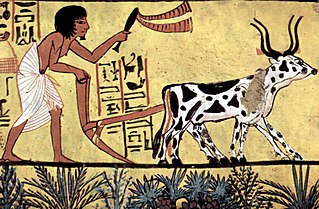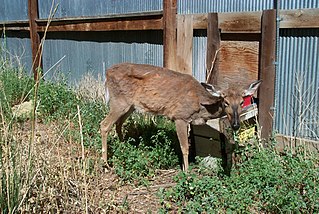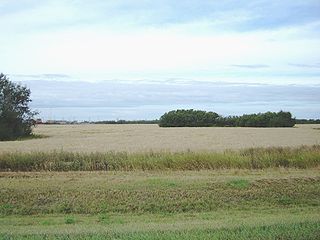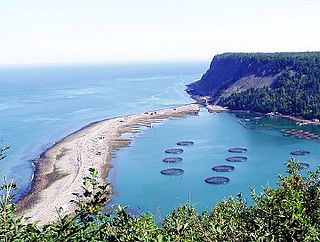
European rabbits were first introduced to Australia in the 18th century with the First Fleet, and later became widespread, because of Thomas Austin. Such wild rabbit populations are a serious mammalian pest and invasive species in Australia causing millions of dollars' worth of damage to crops. Their spread may have been enhanced through the emergence of strong crossbreeds.

Agricultural policy describes a set of laws relating to domestic agriculture and imports of foreign agricultural products. Governments usually implement agricultural policies with the goal of achieving a specific outcome in the domestic agricultural product markets. Well designed agricultural policies use predetermined goals, objectives and pathways set by an individual or government for the purpose of achieving a specified outcome, for the benefit of the individual(s), society and the nations' economy at large. The goals could include issues such as biosecurity, food security, rural poverty reduction or increasing economic value through cash crop or improved food distribution or food processing.

Chronic wasting disease (CWD), sometimes called zombie deer disease, is a transmissible spongiform encephalopathy (TSE) affecting deer. TSEs are a family of diseases thought to be caused by misfolded proteins called prions and include similar diseases such as BSE in cattle, Creutzfeldt–Jakob disease (CJD) in humans and scrapie in sheep. Natural infection causing CWD affects members of the deer family. In the United States, CWD affects mule deer, white-tailed deer, red deer, sika deer, elk, caribou, and moose. The transmission of CWD to other species such as squirrel monkeys and humanized mice has been observed in experimental settings.
Venison originally meant the meat of a game animal but now refers primarily to the meat of deer. Venison can be used to refer to any part of the animal, so long as it is edible, including the internal organs. Venison, much like beef or pork, is categorized into specific cuts, including roast, sirloin, and ribs.

The red deer is one of the largest deer species. A male red deer is called a stag or hart, and a female is called a doe or hind. The red deer inhabits most of Europe, the Caucasus Mountains region, Anatolia, Iran, and parts of western Asia. It also inhabits the Atlas Mountains of Northern Africa; being the only living species of deer to inhabit Africa. Red deer have been introduced to other areas, including Australia, New Zealand, the United States, Canada, Peru, Uruguay, Chile and Argentina. In many parts of the world, the meat (venison) from red deer is used as a food source.

Mycobacterium bovis is a slow-growing aerobic bacterium and the causative agent of tuberculosis in cattle. It is related to Mycobacterium tuberculosis, the bacterium which causes tuberculosis in humans. M. bovis can jump the species barrier and cause tuberculosis-like infection in humans and other mammals.
Helicopter hunting of deer has occurred in the Fiordland area of New Zealand since the 1960s. As long ago as the 1920s, introduced European deer plagued the Fiordland National Park to the detriment of the native New Zealand flora and fauna. The New Zealand government placed a bounty on the deer, paying local hunters for each animal removed from the park. With the market for venison and deerskin, by the 1960s this had proved a lucrative enough business for several hunters to invest in helicopters, to travel fast through the rugged landscape.

Canada is one of the largest agricultural producers and exporters in the world. As with other developed nations, the proportion of the population agriculture employed and agricultural GDP as a percentage of the national GDP fell dramatically over the 20th century, but it remains an important element of the Canadian economy. A wide range of agriculture is practised in Canada, from sprawling wheat fields of the prairies to summer produce of the Okanagan valley. In the federal government, overview of Canadian agriculture is the responsibility of the Department of Agriculture and Agri-Food.

Deer hunting is hunting deer for meat and sport, and, formerly, for producing buckskin hides, an activity which dates back tens of thousands of years. Venison, the name for deer meat, is a nutritious and natural food source of animal protein that can be obtained through deer hunting. There are many different types of deer around the world that are hunted for their meat. For sport, often hunters try to kill deer with the largest and most antlers to score them using inches. There are two different categories of antlers. They are typical and nontypical. They measure tine length, beam length, and beam mass by each tine. They will add all these measurements up to get a score. This score is the score without deductions. Deductions occur when the opposite tine is not the same length as it is opposite. That score is the deducted score.

Field dressing, also known as gralloching, is the process of removing the internal organs of hunted game, and is a necessary step in obtaining and preserving meat from wild animals such as deer. Field dressing is often done as soon as possible after the animal is killed to ensure rapid body heat loss, which prevents bacteria from growing on the surface of the carcass. Field dressing also aids hunters in transporting hunted game by lightening the weight of the carcass.

Agriculture in Saskatchewan is the production of various food, feed, or fiber commodities to fulfill domestic and international human and animal sustenance needs. The newest agricultural economy to be developed in renewable biofuel production or agricultural biomass which is marketed as ethanol or biodiesel. Plant cultivation and livestock production have abandoned subsistence agricultural practices in favor of intensive technological farming resulting in cash crops which contribute to the economy of Saskatchewan. The particular commodity produced is dependent upon its particular biogeography or ecozone of Geography of Saskatchewan. Agricultural techniques and activities have evolved over the years. The first nation nomadic hunter-gatherer lifestyle and the early immigrant ox and plow farmer proving up on his quarter section of land in no way resemble the present farmer operating huge amounts of land or livestock with their attendant technological mechanization. Challenges to the future of Saskatchewan agriculture include developing sustainable water management strategies for a cyclical drought prone climate in south western Saskatchewan, updating dryland farming techniques, stabilizing organic definitions or protocols and the decision to grow, or not to grow genetically modified foods. Domestically and internationally, some commodities have faced increased scrutiny from disease and the ensuing marketing issues.

Rick Hansen is an American politician serving in the Minnesota House of Representatives since 2005. A member of the Minnesota Democratic-Farmer-Labor Party (DFL), Hansen represents District 53B in the southeastern Twin Cities metropolitan area, which includes the cities of South St. Paul, Inver Grove Heights, Cottage Grove and St. Paul Park, and parts of Dakota and Washington Counties.
Elk farming is an agricultural industry for the production of elk as livestock or for the sport of hunting. Elk have a variety of uses. The velvet antler or, the antler in the premature stages of growth, is believed by some to have medicinal purposes. Elk are also raised for venison, their meat. All of these markets are rising in popularity thus causing an increase in the breeding industry. Other species of similar type are farmed in the same way such as deer, moose, and red stag.

The Rocky Mountain elk is a subspecies of elk found in the Rocky Mountains and adjacent ranges of Western North America.

In New Zealand, agriculture is the largest sector of the tradable economy. The country exported NZ$46.4 billion worth of agricultural products in the 12 months to June 2019, 79.6% of the country's total exported goods. The agriculture, forestry and fisheries sector directly contributed $12.653 billion of the national GDP in the 12 months to September 2020, and employed 143,000 people, 5.9% of New Zealand's workforce, as of the 2018 census.

The common brushtail possum was introduced from Australia to New Zealand, where it has become invasive and a major agricultural and conservation pest.

Dairy farming in New Zealand began during the early days of colonisation by Europeans. The New Zealand dairy industry is based almost exclusively on cattle, with a population of 4.92 million milking cows in the 2019–20 season. The income from dairy farming is now a major part of the New Zealand economy, becoming an NZ$13.4 billion industry by 2017.

Aquaculture is the farming of fish, shellfish or aquatic plants in either fresh or saltwater, or both. The farmed animals or plants are cared for under a controlled environment to ensure optimum growth, success and profit. When they have reached an appropriate size, they are harvested, processed, and shipped to markets to be sold. Aquaculture is practiced all over the world and is extremely popular in countries such as China, where population is high and fish is a staple part of their everyday diet.

Animal welfare in New Zealand is governed by the Animal Welfare Act 1999 and a number of organisations actively advocate for both animal welfare and animal rights. Pest control and farming practices have been scrutinised with respect to animal welfare issues. The legality of killing dogs and cats for consumption has also been criticized.
Jamie Becker-Finn is an American politician serving in the Minnesota House of Representatives since 2017. A member of the Minnesota Democratic–Farmer–Labor Party (DFL), Becker-Finn represents District 42B in the northeastern Twin Cities metropolitan area, which includes the cities of Roseville and Shoreview and parts of Ramsey County, Minnesota.















